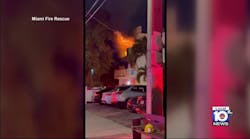Many case studies have proved this axiom. Unfor-tunately, when communications have broken down at some incidents, the results have been the traumatic death of many firefighters. The lessons learned, at such a great expense, must be shared and reinforced to prevent similar situations from occurring. We must learn from our past, or we are doomed to repeat the same costly mistakes. This column will examine the critical communications process as it relates to emergency response and its application within the ICS framework.
Sending & Receiving
The function of communications is described as the conveying of a message from a sender to a receiver through some medium. The sender develops a thought or idea and attempts to convey that exact notion to another person. The sending media are generally written, spoken or non-verbal methods.
It is seldom that complete communication takes place between two individuals. If you are married or if you have teenage children, you know exactly what I mean. This is because there is interference ("noise") associated with the transmission medium. This noise could be volume, speech, speed, accent, terminology, education, hearing or a host of other problems. Any instance when such noise affects the reception of the message falls into this category and lessens the understanding of a message.
To illustrate this concept, I'll describe a personal experience. Eighteen years ago, when I was a new lieutenant, my engine was dispatched to a report of smoke in the attic of a very large wood-frame building. The building covered nearly one city block and had more than a dozen different businesses under roof.
The engine was returning from a previous alarm when this call was dispatched. Because we were a distance from quarters, we ended up arriving behind a battalion chief causing a great deal of early "chaos" ("chief has arrived on scene"). From a location in the attic and without personal protective equipment, the chief radioed for my company to "...bring a handline." Or so I thought.
When a firefighter and I arrived in the attic space (it was large enough to fly a small plane in) with our 1 1/2-inch hoseline, the chief was rather irritated he demanded to know where was the handlight he requested and why had I brought a handline. Unfortunately, he was much clearer in the communication process (in his office) that followed this alarm than he was during the incident. This was one of those "learning opportunities" that I have never forgotten.
Typically, fire-rescue officers communicate using a radio device over some distance under the poorest of conditions. The potential for failed communications is real and steps must be taken to overcome this anticipated problem. Knowing the devastating outcome that poor communications typically causes, we must work diligently to learn techniques that help ensure that messages are correct the first time and every time.
Response personnel should be trained in and use a communication order model. This process will greatly increase a message's chance of being received correctly. The order model that we'll discuss is used in the National Fire Academy's command courses. It requires both the sender and receiver to repeat the message. Once repeated, the message is confirmed or denied. Let's try a few messages to see the system in action.
In this example, we will use a structural fire setting with some simple tasks to be performed. Keep in mind that much like the ICS, the communication order model should be used for all emergencies and not just structural alarms:
"Command to Engine 10."
"Engine 10, go Command."
"Conduct primary search, second floor, Apartment 201."
"Engine 10 copies, conduct primary search, second floor, Apartment 201."
"Command to Engine 10, affirmative."
The likelihood that complete communications has occurred during this transaction is high, compared to the one-way style of communicating. I can recall some situations when orders were issued to a company that was not dispatched to the alarm. When the chief directed the unit to perform a task, he simply made the assumption that because he said it the task was handled. Does this sound familiar?
In the next scenario the message will require a little adjustment:
"Command to Engine 10."
"Engine 10, go Command."
"Supply Truck 13's ladder pipe in the east alley."
"Engine 10 copies, supply Truck 3's ladder pipe in the east alley."
"That's negative, Engine 10 supply Truck 13's ladder pipe in the east alley."
"Engine 10 copies, supply Truck 13's ladder pipe in the east alley."
"Command to Engine 10, affirmative."
Adjustments can be made to correct communication problems long before they become incident problems. This process will lead to a happier and more productive work force eliminating some of that "chaos."
By now, you have noticed that number codes were not used to communicate in the above scenarios. The national trend is to use plain language to communicate during emergencies. The transition to plain text is for several reasons. Many number code variations exist across our country; the meaning of a specific code in one community is completely different from the meaning of the same code number in another.
Next, consider how easy it is to misinterpret various number combinations. The sound-alike number patterns can be a killer of firefighters. And the coded message system is difficult to learn; during the stressful heat of battle, this system may lead to confusing decoding problems. My non-scientific research indicates that the coded message process started with police department applications. The goal was to be able to communicate without the bad guys understanding what the police were doing to stop them. Most fire departments do/did use their community's police dispatch center for communication centers and thereby adopted number codes by proxy.
Every department should have a standard operating guideline that indicates how the communications process will work in that department. Included should be all of the items that we have discussed.
Speaking slowly and clearly can help eliminate the noise in your messages. Some radio systems require that the user pause a second or two (after keying the mike) before transmitting a message. You need to add these types of particulars about your system into your guidelines.
Use the incident benchmarks to keep everyone connected and on the right page of the "playbook." These three benchmarks align with the three incident priorities. For the life safety priority, the communication benchmark is "all clear." The "all clear" benchmark means that primary search has been completed. Incident stabilization is designated by the transmission of "under control." The incident is no longer escalating and will soon be resolved. When property conservation is completed, it is identified by the benchmark "loss stopped." The salvage needs have been addressed and met.
To sum up the basics of incident communications keep several thoughts in mind:
- The communications process is critical to your department's success. Practice and use the communications order model with plain text language. These two items alone will greatly enhance your communications abilities.
- The benchmarking process helps to keep all operating resources at an incident connected and informed as to the ongoing action plan.
- Your department should develop and routinely revise a communications guideline that all members can learn and use effectively.
- Practice and train regularly using all of the elements of the incident command system, including the communications procedures.
If your department consistently uses the incident command system properly, you will be delivering a higher quality service to your customers, while keeping your members safer. Until next time, safe firefighting!
Dennis L. Rubin, a Firehouse® contributing editor, is chief of the Dothan, AL, Fire Department.





